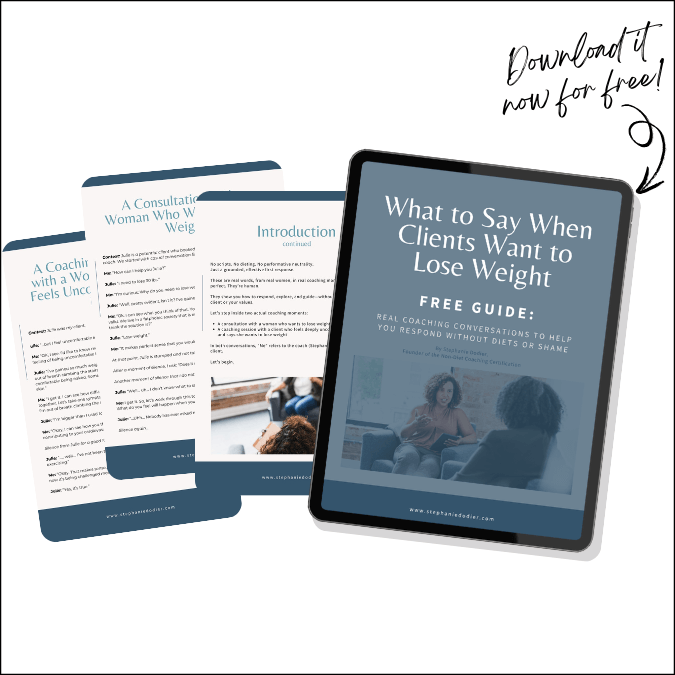

In this episode of the It’s Beyond The Food Show podcast, I’m breaking down what makes body image seem complex and offering a roadmap to healing.
Beyond the Surface: What Is Body Image?
Many people mistakenly believe body image is simply about how we look in a mirror. The truth is far more nuanced. Psychological research reveals body image comprises four critical components:
1. Perceptual Body Image: How we visually see our body
2. Cognitive Body Image: How we think about our body
3. Affective Body Image: How we feel about our body
4. Behavioral Body Image: How we act based on our body perception
The Hidden Layers of Body Image Complexity
Many people struggle to understand body image beyond surface-level perceptions. The complexity lies not just in how we see ourselves, but in the intricate web of thoughts, emotions, and behaviors that shape our self-perception. Each layer of body image interacts dynamically, creating a deeply personal experience that goes far beyond simple visual judgment. Recognizing these interconnected components is the first step in breaking free from limiting beliefs and creating a more compassionate relationship with our bodies.
Cognitive Aspects: Reshaping Thoughts
Cognitive behavioral coaching is the gold standard for addressing body image challenges. This approach focuses on understanding and transforming thought patterns and belief systems. We work to challenge negative self-talk and create more compassionate internal narratives.
Emotional Regulation: Processing Feelings
Many struggle with emotional intelligence around body image. Learning to recognize, process, and sit with emotions is crucial. Most individuals need fundamental skills to:
– Understand their emotional responses
– Release shame
– Build body confidence
Protective Behaviors: Unconscious Coping Mechanisms
Body image impacts behavior in subtle ways. Common protective behaviors include:
– Hiding body parts with cushions or clothing
– Adjusting clothing to minimize perceived “flaws”
– Inconsistent exercise patterns driven by body shame
Trauma-Informed Body Image Approach
Body image challenges can be deeply traumatic, especially in a society that perpetuates harmful beauty standards. As a professional who has worked with countless women, I recognize that body image is more than a surface-level concern – it’s a profound emotional experience.
Understanding Trauma in Body Image
Trauma is a physical, emotional, and cognitive response to circumstances experienced as harmful. In the context of body image, this trauma manifests in multiple ways:
– Physical Trauma: How we perceive and experience our body
– Emotional Trauma: Intense feelings of shame and inadequacy
– Cognitive Trauma: Persistent negative self-talk and critical thoughts
The Core of Trauma-Informed Healing
The primary principle of a trauma-informed approach is creating safety. This safety encompasses multiple dimensions:
1. Internal Safety: Learning to stop self-criticism and internal harm
2. Relational Safety: Building trust with coaches and support systems
3. Environmental Safety: Navigating a society that often feels unwelcoming
Resilience: Navigating Triggers with Confidence
Healing doesn’t mean avoiding triggers – it means building the emotional intelligence to handle them gracefully. For instance, I still get triggered when squeezing into airplane seats after years of work. The difference? I now know exactly how to process those emotions.
Practical Strategies for Trauma-Informed Healing
– Recognize triggers without judgment
– Develop emotional regulation techniques
– Practice self-compassion
– Build a supportive, non-judgmental internal dialogue
Breaking the Cycle of Trauma
A trauma-informed approach moves beyond traditional healing methods. It acknowledges that body image trauma is real, valid, and deserves compassionate attention. We’re not trying to “fix” your body – we’re helping you create a safe, loving relationship with yourself.
Intersectionality: Recognizing Unique Experiences
Body image is not universal. Factors like gender, race, and cultural background significantly influence body perception. For instance, body size might represent wisdom and power in one culture but be stigmatized in another.
Beyond cultural differences, intersectionality reveals how multiple identities interact to shape body image experiences. Disability, sexuality, age, and socioeconomic status also profoundly impact how individuals perceive and experience their bodies. A queer woman of color will navigate body image challenges differently than a white heterosexual woman, reflecting the complex interplay of societal expectations, personal history, and systemic influences.
Body Autonomy: A Collaborative Path to Healing
Healing requires a collaborative coaching model that empowers individuals. Traditional diet-culture approaches often strip away personal agency, creating a cycle of external control and internal shame. By shifting to a collaborative approach, we recognize that each individual is the expert of their own body and experience.
This method encourages self-discovery, critical thinking, and personal empowerment, moving away from prescriptive, one-size-fits-all solutions. This means:
– Asking questions
– Facilitating self-discovery
– Avoiding prescriptive, diet-culture approaches
What listeners will learn listening to this podcast episode:
- The four interconnected components of body image
- How to recognize unconscious protective behaviors
- Techniques for emotional regulation around body perception
- The importance of a trauma-informed approach to body healing
Remember, body image is not a complex puzzle to solve but a relationship to nurture with compassion and understanding.





